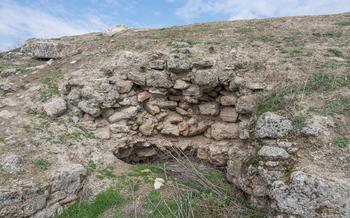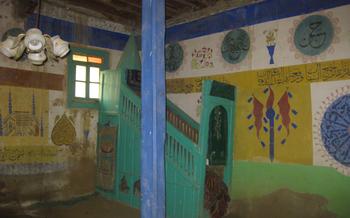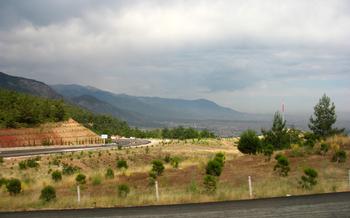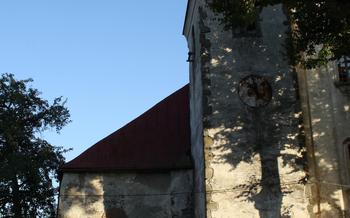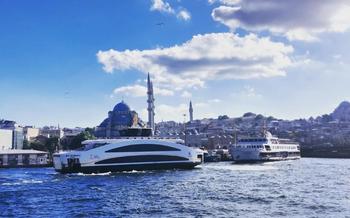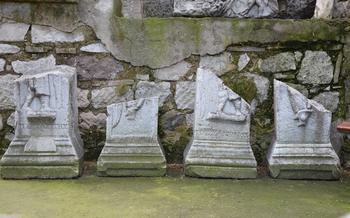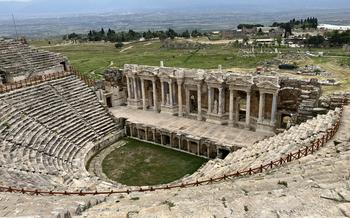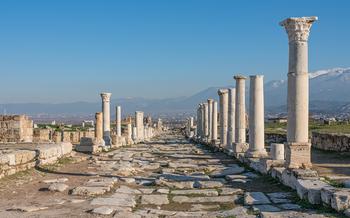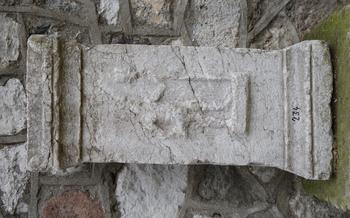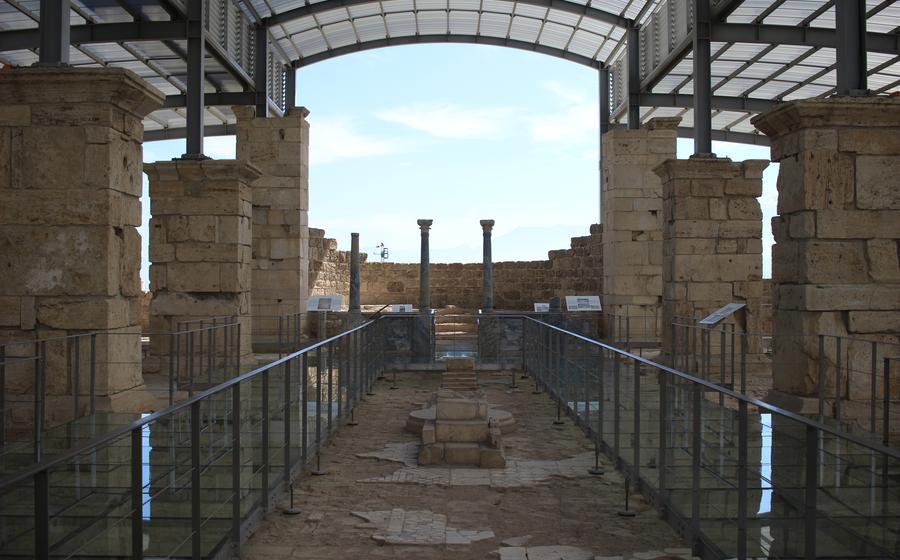
Church of Laodicea
- Historical Significance
- Location and Accessibility
- Excavations and Discoveries
- Architectural Marvels
- Mosaics and Artwork
- Religious Importance
- Restoration and Conservation
- UNESCO World Heritage Site
- Tourism and Visitor Experience
- History Museum
- Nearby Attractions
- Local Cuisine and Restaurants
- Accommodation Options
- Insider Tip: Unveiling the Hidden Gem of Hierapolis
Historical Significance
Laodicea, a city steeped in rich history, traces its origins back to the Hellenistic period. Founded by Antiochus II around 261-250 BC, it was strategically positioned along major trade routes and flourished as a commercial hub. Its significance grew during the Roman era when it became a prominent center for trade and textile production. Laodicea played a pivotal role in the spread of Christianity, earning recognition as one of the Seven Churches of Revelation mentioned in the Bible. The city remained a vital metropolis throughout the Byzantine period, serving as a center for religious and cultural exchange.
Location and Accessibility
Laodicea is situated in the city of Denizli, in southwestern Turkey. It lies approximately 6 kilometers east of the city center, along the banks of the Lycus River. The site is easily accessible by car, with well-maintained roads leading to the ruins. Visitors can also opt for public transportation, with regular buses departing from Denizli's main bus station to the nearby village of Goncalı. From there, a short walk or taxi ride will take you to the ruins. Laodicea's strategic location, nestled amidst other ancient cities such as Hierapolis and Colossae, makes it an ideal destination for history and archaeology enthusiasts seeking to explore the rich cultural heritage of the region.
Excavations and Discoveries
Extensive archaeological excavations have been conducted at Laodicea, shedding light on the city's rich history and significance. These excavations have uncovered a wealth of impressive structures, artifacts, and mosaics that provide valuable insights into the daily lives, culture, and religious practices of the ancient inhabitants.
One of the most notable discoveries at Laodicea is the impressive theater, which could accommodate up to 15,000 spectators. The theater's well-preserved stage, intricate carvings, and impressive acoustics showcase the city's appreciation for the arts and entertainment.
Another significant find is the stunning nymphaeum, a monumental fountain adorned with intricate reliefs and sculptures. This elaborate fountain served as a public gathering place and a symbol of the city's wealth and prosperity.
Furthermore, the excavations have revealed a vast network of underground tunnels and chambers, known as the Phrygian Valley. These tunnels were likely used for religious rituals, storage, or as a refuge during times of danger.
The ongoing efforts to preserve and restore the site have ensured that these remarkable discoveries remain accessible to visitors, providing a glimpse into the grandeur and complexity of ancient Laodicea.
Architectural Marvels
The Church of Laodicea stands as a testament to the architectural prowess of its builders. Constructed during the 4th century AD, the church boasts a unique blend of early Christian and Romanesque architectural styles. Its impressive dimensions, measuring approximately 60 by 25 meters, speak to the grandeur of the city and the importance of Christianity in Laodicea.
The church's most striking feature is its three-aisled basilica design, a layout common in early Christian architecture. The nave, the central aisle, is flanked by two narrower aisles, creating a sense of spaciousness and grandeur. The aisles are separated by rows of massive columns, each adorned with intricate carvings and capitals.
The apse, the semicircular recess at the eastern end of the church, is another notable architectural element. It houses the altar, the focal point of Christian worship. The apse is decorated with a series of niches, each containing a statue of a saint or biblical figure.
The church's exterior is equally impressive, showcasing a combination of stone and brick construction. The walls are adorned with decorative elements such as blind arches, pilasters, and cornices, adding depth and ornamentation to the structure.
Overall, the architectural grandeur of the Church of Laodicea reflects the city's prosperity and the importance of Christianity in the region during the Roman and Byzantine periods.
Mosaics and Artwork
The Church of Laodicea is renowned for its exquisite mosaics that adorn the floors and walls. These intricate artworks depict a variety of biblical narratives and symbols, offering a glimpse into the beliefs and practices of early Christians. Among the most notable mosaics is the depiction of the story of David and Goliath, where David is portrayed as a young shepherd facing the giant Goliath. Another captivating mosaic showcases the parable of the Good Samaritan, highlighting the themes of compassion and mercy. Visitors can also admire the intricate geometric patterns and floral motifs that embellish the church's interior, creating a visually stunning and immersive experience. These mosaics not only serve as decorative elements but also provide valuable insights into the artistic and cultural heritage of the early Christian community.
Religious Importance
The Church of Laodicea carries immense religious significance as a prominent center of early Christianity. It played a crucial role in spreading the Christian faith throughout the region and beyond. The church was mentioned in the Bible's book of Revelation, where it was addressed in a letter from Jesus Christ. This reference underscores the church's importance in the early Christian world.
The Church of Laodicea was a gathering place for believers and a site for religious ceremonies and teachings. It served as a hub for the dissemination of Christian doctrine and the propagation of the faith. Notable religious figures, such as the apostle Paul, are believed to have visited the church and contributed to its spiritual growth.
Moreover, the church played a significant role in the development of Christian theology and liturgy. It was a venue for theological debates and discussions, shaping the beliefs and practices of the early Christian community. The church's rich history and religious significance make it a revered site for Christians worldwide.
Restoration and Conservation
Preserving and restoring the Church of Laodicea is of utmost importance, as it represents a tangible link to early Christianity and the rich cultural heritage of the region. However, the site faces several challenges that hinder its conservation efforts.
One significant challenge lies in the natural elements that have gradually eroded and damaged the church's structures. The passage of time, coupled with exposure to harsh weather conditions, has led to the deterioration of the church's stonework, mosaics, and other architectural features.
Another challenge stems from the site's historical significance, which attracts a large number of visitors. While tourism is vital for raising awareness and generating revenue for restoration efforts, it also poses a threat to the delicate remains of the church. The sheer volume of foot traffic can accelerate the wear and tear on the ancient ruins, making it crucial to strike a balance between accessibility and preservation.
To address these challenges, comprehensive restoration and conservation projects have been undertaken by the Turkish government and international organizations. These projects involve careful cleaning, stabilization, and repair of the church's structures, using traditional techniques and materials to maintain the authenticity of the site.
Ongoing efforts also focus on the preservation of the church's exquisite mosaics. Skilled conservators work meticulously to restore the vibrant colors and intricate designs of these artworks, ensuring their survival for future generations.
Through these dedicated restoration and conservation initiatives, the Church of Laodicea is being safeguarded as a testament to the enduring legacy of early Christianity and the architectural prowess of the ancient world.
UNESCO World Heritage Site
The Church of Laodicea, with its exceptional architectural and historical significance, has been proposed for inclusion on the prestigious UNESCO World Heritage Site list. This designation recognizes sites of outstanding universal value and cultural heritage. The church meets several criteria that make it eligible for this honor.
Firstly, the Church of Laodicea represents a unique and remarkable example of early Christian architecture. Its well-preserved state and intricate design showcase the architectural prowess of the era. The church's mosaics, with their intricate patterns and biblical scenes, are particularly noteworthy and contribute to its exceptional value.
Secondly, the church holds immense historical significance as one of the Seven Churches of Revelation mentioned in the Bible. Its association with early Christianity and its role in the spread of the faith make it a site of profound religious and cultural importance. The church's enduring legacy and its influence on the development of Christianity further enhance its eligibility for UNESCO recognition.
Obtaining UNESCO World Heritage status would bring numerous benefits to the Church of Laodicea. It would increase international awareness and recognition of the site, attracting more visitors and promoting cultural tourism in the region. Additionally, UNESCO designation would provide access to funding and resources for ongoing conservation and restoration efforts, ensuring the preservation of this invaluable heritage for future generations.
Tourism and Visitor Experience
Visiting the Church of Laodicea is a unique and enriching experience for travelers interested in history, archaeology, and religion. The site is open to the public daily, and visitors can explore the ruins at their own pace or join a guided tour. Guided tours are highly recommended as they provide valuable insights into the history and significance of the church. Several tour operators offer guided tours of Laodicea, and visitors can choose from various options to suit their interests and budget.
The church is surrounded by a well-maintained park, providing a serene and picturesque setting for visitors to relax and admire the ancient ruins. Several visitor facilities and amenities are available on-site, including restrooms, a small café, and a gift shop. Visitors can purchase souvenirs, books, and other items related to the history and culture of Laodicea at the gift shop.
The church is wheelchair accessible, and visitors with disabilities can easily navigate the site. The park surrounding the church is also stroller-friendly, making it easy for families with young children to visit.
For those interested in learning more about the history of Laodicea, the Laodicea History Museum is located nearby. The museum houses a collection of artifacts and exhibits showcasing the city's rich history and cultural heritage. Visitors can learn about Laodicea's role in the ancient world, its economic and social life, and its contributions to Christianity.
History Museum
A visit to the Church of Laodicea can be complemented by exploring the Laodicea History Museum, located a short distance from the church. This museum houses a wealth of artifacts and exhibits that shed light on the rich history and cultural heritage of Laodicea.
The museum's collection includes a diverse array of items, such as ancient coins, pottery, sculptures, and inscriptions. These artifacts provide valuable insights into the daily lives, customs, and beliefs of the people who inhabited Laodicea throughout different periods of history.
One of the highlights of the museum is a collection of well-preserved mosaics that depict scenes from Greek mythology and everyday life. These mosaics offer a glimpse into the artistic traditions and craftsmanship of the ancient Laodiceans.
The museum also features interactive displays and multimedia presentations that bring the history of Laodicea to life. Visitors can learn about the city's role in the ancient world, its economic and cultural significance, and its contributions to the development of Christianity.
A visit to the Laodicea History Museum is an excellent way to delve deeper into the fascinating story of this ancient city. It provides a comprehensive overview of Laodicea's past and helps visitors appreciate the enduring legacy of this once-thriving metropolis.
Nearby Attractions
In the vicinity of Laodicea, history buffs will delight in exploring other ancient sites and landmarks. The ancient city of Hierapolis, with its well-preserved Roman baths and amphitheater, is a must-see. Pamukkale, renowned for its cascading travertine terraces and mineral-rich hot springs, offers a unique natural wonder. For a glimpse into early Christian history, visit the Colossae, where the Apostle Paul preached and established a church. These nearby attractions, each with its own historical significance and charm, provide a comprehensive journey through the region's rich past.
Local Cuisine and Restaurants
The city of Denizli, where Laodicea is located, boasts a rich culinary heritage influenced by its diverse history and geography. Visitors to the region should not miss the opportunity to savor the local delicacies.
One of the signature dishes of Denizli is "keşkek," a hearty stew made from wheat, meat, and spices. This traditional dish is often served at special occasions and celebrations. Another must-try is "bamya çorbası," a flavorful okra soup that combines okra, tomatoes, onions, and garlic.
For a taste of local street food, try "lahmacun," a thin, crispy flatbread topped with minced meat, vegetables, and spices. "Köfte," Turkish meatballs, are another popular choice, often served with rice or bulgur.
To accompany these dishes, visitors can enjoy a glass of "şalgam suyu," a fermented turnip juice that is unique to the region. For dessert, indulge in "lokum," also known as Turkish delight, a sweet and chewy confection made with sugar, starch, and various flavors.
When dining near the Church of Laodicea, several restaurants offer traditional Turkish cuisine. Visitors can choose from cozy eateries to upscale establishments, each providing a unique dining experience. Be sure to ask for recommendations from locals or your hotel concierge to discover the best culinary spots in the area.
Accommodation Options
When planning a visit to the Church of Laodicea, travelers have a range of accommodation options to choose from, catering to different budgets and preferences. For those seeking a comfortable and convenient stay near the church, the Laodicea Hotel offers modern amenities and a prime location. The hotel features well-appointed rooms, a welcoming ambiance, and friendly service.
For a more immersive experience, visitors can opt to stay in one of the charming guesthouses in the vicinity. These traditional accommodations offer a glimpse into local culture and provide a unique opportunity to interact with the friendly residents of Denizli. The guesthouses often feature cozy rooms, delicious home-cooked meals, and picturesque surroundings.
For travelers seeking a unique and memorable stay, the region offers several boutique hotels and resorts that blend modern comforts with traditional Turkish charm. These accommodations provide a luxurious retreat, allowing visitors to unwind and rejuvenate after exploring the ancient ruins.
Insider Tip: Unveiling the Hidden Gem of Hierapolis
As you explore the Church of Laodicea, take a moment to venture beyond its walls and discover the neighboring ancient city of Hierapolis. Often overshadowed by its more famous counterpart, Pamukkale, Hierapolis boasts a wealth of well-preserved ruins, including a stunning theater, a necropolis with elaborate tombs, and the remains of a once-magnificent temple complex. For an unforgettable experience, plan a day trip to Hierapolis and immerse yourself in the rich history and architectural wonders of this hidden gem.
